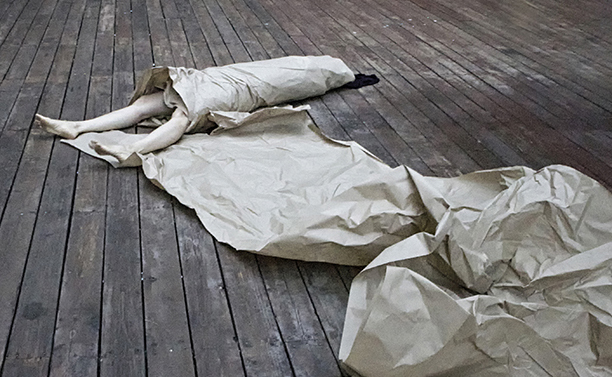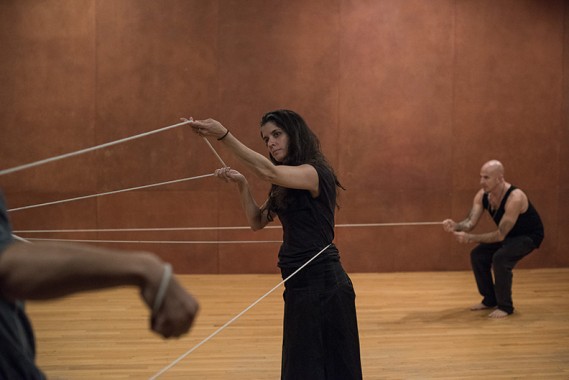Janine Antoni Uses Movement to Look Back in ALLY

Janine Antoni in collaboration with Anna Halprin, Paper Dance, 2013. Photo credit: Pak Han at the Halprin Dance Deck.
Janine Antoni (2012 Awardee) premieres her Creative Capital project, Ally, at The Fabric Workshop and Museum in Philadelphia, opening April 21, 2016. Ally is an exhibition of art and dance conceived and performed by Antoni in collaboration with choreographer Stephen Petronio and movement artist Anna Halprin. Taking the form of performances, installation environments, videos and sculptures, Ally will occupy four floors of the museum for three months, with weekly live performances. A book will follow, edited by the British writer and performance scholar Adrian Heathfield.
Antoni writes, “I conceived of this project more than six years ago as a kind of retrospective of my art making, told through dance. It has evolved into a truly collaborative creation that allows us to find a way to continue making new work while looking back.”
Ally is comprised of four projects: Rope Dance, an improvised performance instigated by Halprin, who presented a rope to Antoni and Petronio to be used as a tool to connect their bodies and draw lines through space; Swallow, a complex installation based on a performance by Antoni and Petronio, who connected from the gut using a 10-foot strip of woven cloth; The Courtesan and the Crone, a dance of seduction originally created and performed by Halprin in 1999, reimagined here in a different gender and generational context as a solo performance by Petronio; and Paper Dance, an improvised performance by Antoni with rolls of brown paper in an environment that refers to both Antoni and Halprin’s artistic histories.
Jenny Gill connected with Janine to learn more about the development of Ally and her deeply collaborative process.
Jenny Gill: The works in Ally all sound incredibly complex and layered, but Paper Dance strikes me as particularly rich. Not only is it a weekly performance, but it is performed within a “set” of crated artworks from your artistic history. With each performance, you unpack and repack different artworks, so over the course of the 14 weeks of the show, a mini-retrospective of your past work emerges. Can you talk more about the role of these artworks in the performance and the exhibition?
Janine Antoni: When I first conceived of my project for Creative Capital, I wanted to make a retrospective of my work in dance. For me, it was a way to look back with the intention of moving forward. It was Anna Halprin’s idea to take a section of her work Parades and Changes (1965) as a score for me to do as a solo—she presented me with the rolls of paper she originally used to create that piece.
In the process of improvising movement with the paper, I started to notice how images from my past artworks were presenting themselves to me. It became clear that the lessons learned in the making and the conceptual concerns of my work have etched themselves into my psyche. In Paper Dance, there is a beautiful symmetry as both Anna and I are reconfiguring our pasts.
When I perform Paper Dance, the audience will see a simple roll of brown paper transform endlessly by being in contact with my body. This coming and going of imagery is echoed in the packing and unpacking of my work. For me, the paper is alive and its material qualities are directing my movement. My past artworks hold a similar resonance for me. During each performance, the unpacked artwork will witness my movement along with the audience—and even the pieces that are crated and unseen hold a palpable presence and will influence my movement.

Janine Antoni, Anna Halprin, Stephen Petronio, Rope Dance, 2015. Photo: Hugo Glendinning.
Jenny: In your writing about Rope Dance, you’ve talked about a “spiral of creativity” that you see when one artist “makes” a dance for another artist, transforming their actions and initiating a creative response, then in turn the creator / choreographer can themselves be transformed by witnessing the dance. In a sense, they can create their own performance as they experience the creative act taking place outside of their own body. Can you talk more about how these layers of creativity, action and response are woven into the presentation of Ally?
Janine: I was instinctually drawn to the work of Anna Halprin and Stephen Petronio. Making Ally, has been a process of finding a place where we can meet. In this journey, I have been following my nose and letting the process lead us. It has been an incredible experience to bring our distinct languages and belief systems to the table and to engage in the fruitful, and sometimes difficult, conversations that shape the work.
Rope Dance has gone through enormous changes. This is because it is the work that incorporates all three collaborators. In the end, we give it to the audience. They become the movers. Between performances, viewers will see the performance on the face of its maker: captured in video is Anna’s face not only witnessing her creation, but also doing what all great choreographers do—seeing it through the eyes of her audience.
Jenny: It sounds like you’ve considered the role of the audience very deeply in all of these projects. Do you have different, specific audiences in mind for each piece, or different types of audience interaction?
Janine: Yes. In The Courtesan and the Crone, we allude to a traditional theatrical setting with all of its viewing tropes but the theater is clearly situated as an object within a gallery setting. In Paper Dance, the audience and the artworks are both treated as witnesses to the dance. In Rope Dance, as I said earlier, the viewers are incorporated into the dance and re-evaluate their witnessing from the perspective of participation. In Swallow, the audience is left to piece together fragmented documentation that takes the form of spoken stories, relics and a single image. My hope is that the breadth of our collaboration is reflected in the diversity of the audience that Ally attracts.
Jenny: You received the Creative Capital award for Ally in 2012. In the four years of the project’s development, how has it changed from your original idea? What surprises or discoveries about yourself and your practice happened along the way?
Janine: Anna introduced me to my infinite interiority and gave me the confidence to trust myself in the moment. I can say improvisation has changed my personality.
As far as the project is concerned, I have come such a long way from my original proposal for Creative Capital—but then again, as we discussed earlier, I see the creative process as more of a spiral than a straight line. Although I have traveled far away from my original thoughts, it is not a surprise to me that I have circled back around to tackle those ideas from a more knowledgeable place. Since Ally is a collaboration with two choreographers, the process has taken me out of my chosen field. I have come to see the assumptions and prejudices that stem from my own belief system as a visual artist.
Jenny: What advice do you have for artists or performers who are just starting out?
Janine: Dive into the unknown and pay attention.
Ally is on view at The Fabric Workshop and Museum in Philadelphia from April 21 to July 31, 2016. Detailed descriptions of all four projects in Ally are available in the press release.
